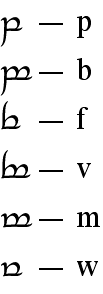A phonemic feature writing system
 The first writing systems basically had a character for each word; then syllabic writing systems were invented, in which each character corresponds to a syllable; and finally alphabetic writing was invented, where each character more or less corresponds to a phoneme.
The first writing systems basically had a character for each word; then syllabic writing systems were invented, in which each character corresponds to a syllable; and finally alphabetic writing was invented, where each character more or less corresponds to a phoneme.
Wouldn’t it be logical to continue the development to achieve a writing system having one character for each distinctive feature in the phonological system?
To the best of my knowledge, only Tolkien’s Tengwar has really explored this route (see the examples on the left), but it never seems to have got any further.
This is a shame, because such a writing system would have very desirable properties.
 For instance, many languages only allow homorganic nasals in front of stops (i.e., only /mp, nt, ?k/ and not */mk, np, ?t/ etc.); however, in an alphabetic writing system one has to choose a symbol, such as ‘n’ or ‘m’, because there is no symbol for a nasal stop that does not have a defined place of articulation (occasionally I’ve seen /N/ used for this, but that doesn’t save any ink). Imagine how wonderful it would be if we could just writing the symbol for ‘nasal’ and leave out any symbol for the place of articulation.
For instance, many languages only allow homorganic nasals in front of stops (i.e., only /mp, nt, ?k/ and not */mk, np, ?t/ etc.); however, in an alphabetic writing system one has to choose a symbol, such as ‘n’ or ‘m’, because there is no symbol for a nasal stop that does not have a defined place of articulation (occasionally I’ve seen /N/ used for this, but that doesn’t save any ink). Imagine how wonderful it would be if we could just writing the symbol for ‘nasal’ and leave out any symbol for the place of articulation.
Similarly, when in Spanish [d] and [ð] are variants of one phoneme, it would be great if we could just denote it with the symbols for ‘dental/alveolar’, ‘voiced’ and perhaps ‘non-nasal’. On the right, I’ve outlined how this could potentially work.
This is just a rough outline. There are several problems with my proposal, e.g., the signs for ‘nasal’ and ‘fricative’ look the same if the place of articulation is removed, and there’s no obvious way to write ‘non-nasal’.
However, I’m sure these issues would be relatively simple to resolve.
It might be that such a writing system would never catch on as the everyday writing system of any language, but it could perhaps replace IPA as the preferred system for phonemic transcriptions.
Isn’t Hangeul, the Korean script, basically feature-based? It clusters in syllables, too!
I don’t think it’s properly feature-based, but the character shapes are to some extent not random (i.e., ‘b’ and ‘p’ are different in the same way as ‘d’ and ‘t’). However, I don’t think it’s possible to create a character for a nasal stop without showing its place of articulation, so it’s still essentially phoneme-based rather than feature-based. I’m not a Hangul expert, though.